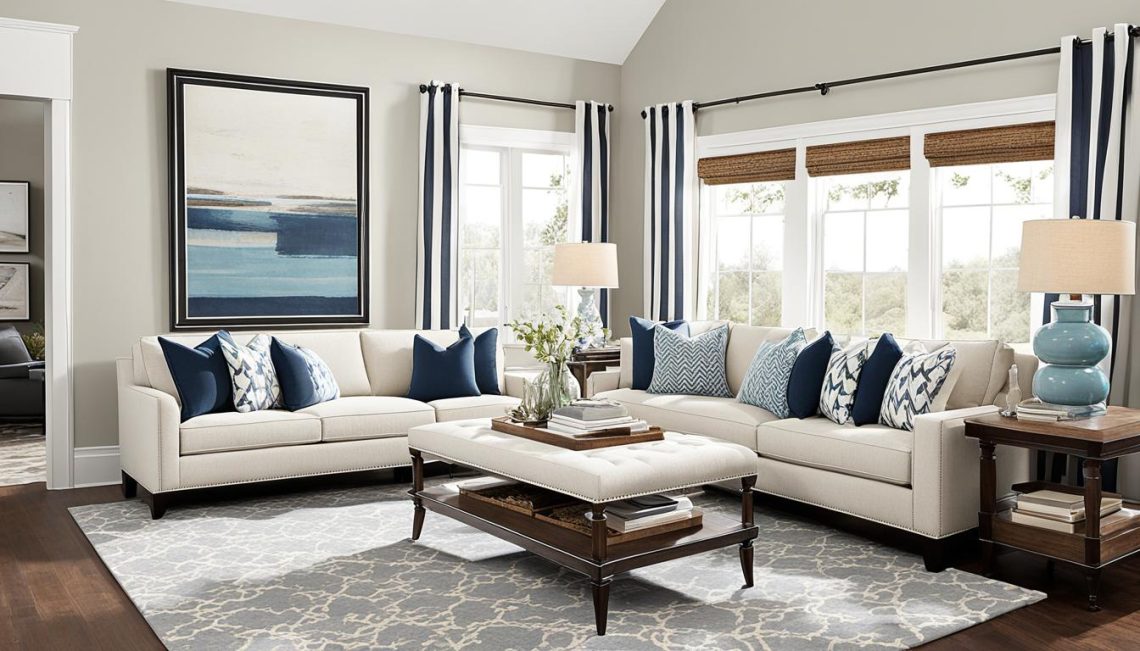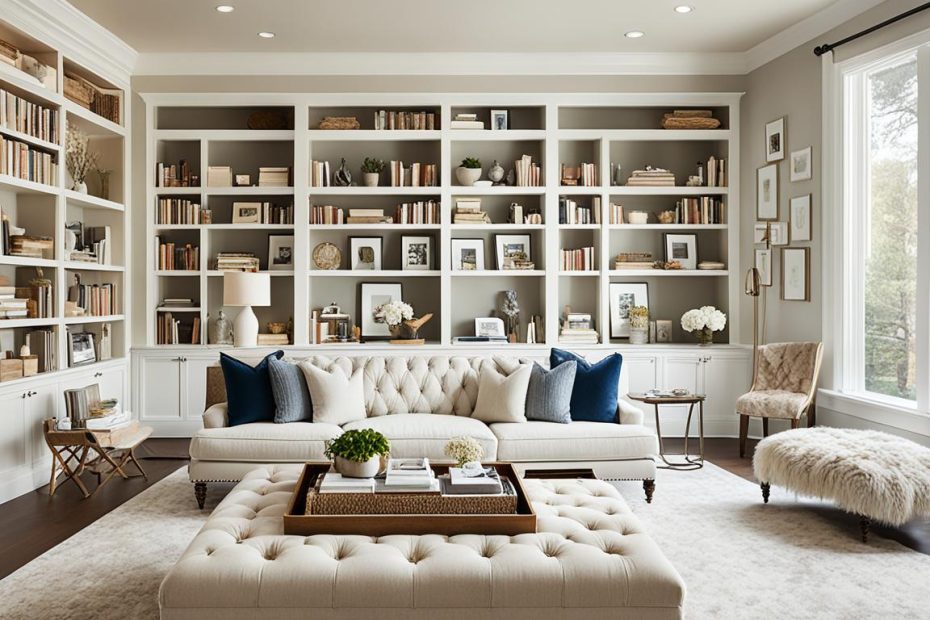When assessing your living space furniture, it’s not only about filling the room—it’s about choosing pieces that elevate functionality, comfort, and home aesthetics. In the realm of central living room pieces, the storied debate between the plush versatility of an ottoman and the classic utility of a coffee table continues to engage homeowners and designers alike. Discover the ottoman benefits that can transform your sitting area into a haven of relaxation and the coffee table advantages that infuse convenience and style into your daily living. These are more than mere furnishings; they’re the twin pillars that uphold the essence of a modern, well-appointed home.
The choice between an ottoman and a coffee table does not hinge solely on aesthetics; it’s an intersection where design meets personal lifestyle. Do you value a soft, adaptable surface for lounging, or do you lean towards a sturdy stage for your elegant decor and evening refreshments? As we delve deeper into this home furnishing conundrum, we invite you to consider not only how each piece complements your decor but also how they can enhance your day-to-day living experience in your cherished abode.
Understanding Ottoman and Coffee Table Functions in Your Home
When it comes to refining your living space, the incorporation of the right furniture design can dramatically enhance both aesthetics and functionality. Whether rounding off your living room accessories with an ottoman or anchoring the space with a coffee table, each piece plays a pivotal role in home décor. Here, we delve into the essentials of these functional furnishings and how they can optimize your living environment.
Defining the Essentials: What Are They?
Emerging as key elements in interior decorating strategies, both ottomans and coffee tables offer unique benefits to your home interior choice. An ottoman stands out with its plush, upholstered form, serving not just as a footstool but also frequently as a coffee table alternative or extra seating. Available in myriad shapes and upholstery styles, ottomans invite versatility into home furniture design. Coffee tables, conversely, are typically recognized by their sturdy surface space and often come with additional features such as drawers or shelves, enhancing their status as living room essentials.
Key Distinctions Between Ottomans and Coffee Tables
Distinguishing furniture features are paramount in the differentiation between ottomans and coffee tables. Ottomans are often designed with comfort in mind, featuring soft edges and a touch of embedded storage. Ideal for lifestyle furnishings that demand adaptability, they add warmth to a space. Coffee tables propose a more fixed presence as a functional furnishing, usually easier to maintain and capable of supporting everyday activities with a solid, steady surface.
The Multifaceted Roles of Coffee Tables and Ottomans
Where living space optimization is key, versatile home furniture like ottomans and coffee tables play a myriad of roles. Coffee tables serve as a pivot for social gatherings, while ottomans can transition into additional tabletops, footrests, or visually soften a room. Both have the potential to conceal clutter, embodying the principles of multi-use furnishings. Each selection offers a pathway to reflect personal taste and can markedly influence the overall room ambiance through strategic interior decorating.
As you navigate the choices that define your living area, remember that neither an ottoman nor a coffee table is simply a piece to fill a gap; they are focal points of design and comfort. Your home is a reflection of your lifestyle, and these furnishings are the touchstones of a thoughtful, functional living space. Choosing furniture is not simply about filling your home with objects, but rather about curating an environment that aligns seamlessly with your daily life and aesthetic leanings. Whether it’s an ottoman that adds a soft touch to your decor or a coffee table that stands as a testament to clean design, each element is a stitch in the fabric of what makes your house a home.
Ottoman or Coffee Table: Analyzing Space and Placement
Choosing between an ottoman and a coffee table is more than just picking out a furniture piece; it’s about making an informed furniture arrangement decision that affects your daily activities and the aesthetic of your home. The primary focus is on interior space planning, which involves assessing the room’s size and existing furnishings to determine which option would contribute to effective home space utilization. Key to this decision-making process is the optimal furniture placement; this not only provides convenience and comfort but also maintains the flow and function of your living space.

When it comes to furniture, one must think spatially first and stylistically second. The best interiors are a cohesive blend of form, function, and aesthetics.
The ideal distance from the edge of your seating to your ottoman or coffee table is between 12 to 18 inches. This clearance affords easy reach while maintaining enough space for comfortable movement. This spacing is not accidental but a considered element of furniture arrangement, ensuring that the pieces serve their intended purpose without contributing to clutter or hindrance.
| Location | Ottoman Placement | Coffee Table Placement |
|---|---|---|
| Living Room | Proportional to seating, allows for footrest or extra seating | Centerpiece, provides stable surface for items |
| Bedroom | At bed’s end matching bed’s width and slightly lower in height | Not commonly placed in this area |
| Spaces with Children | Soft edges, often with storage space | Requires careful selection for safety and durability |
| Small Spaces | Can be a space-saving option if size-appropriate | Must be chosen with a careful eye on proportions and scale |
Incorporating either an ottoman or a coffee table requires attention to scale. If you possess a spacious living room, a large, statement coffee table might serve as an anchor in the room’s arrangement. Conversely, a snug, cushioned ottoman can provide vital additional seating without overwhelming a compact area.
- Measure your couch or seating area and ensure the furniture you choose matches in scale and height.
- Consider the primary use of the space to decide between the multipurpose flexibility of an ottoman and the structural utility of a coffee table.
- Reflect on the overall aesthetic and functionality of the space before making your final selection.
Your intelligent approach to furniture arrangement will have a lasting effect on the enjoyment and utility of your interior space. Whether it’s an ottoman that doubles as storage or a coffee table that stands as a gathering point in your home, making the right choice will lead to a more organized and inviting living environment.
Selecting the Right Style and Material for Your Living Space
Creating a harmonious interior design in your living space is not only a matter of style synchronization but also a strategic exercise in furniture selection that adheres to a cohesive living space theme. The right selection, sizing, and material of your furnishings not only elevate the design aspect of your home but also contribute to long-lasting use and ease of maintenance.
Matching Ottomans and Coffee Tables with Existing Decor
Ensuring style harmony begins with furniture material selection that complements the overall aesthetic you’re aiming for. If your living area embraces a contemporary vibe, consider metal or glass coffee tables that reflect sleekness and simplicity. For a traditional setting, wood with rich tones or marble can add a touch of elegance. When integrating ottomans, look for upholstery that echoes the color palette and texture of your sofa or accent chairs, solidifying that cohesive living space theme.
Considering Longevity: Material Durability and Maintenance
When anticipating furniture wear and tear, it’s crucial to select materials that are not only durable but also cater to easy maintenance furniture requirements. Opt for surfaces that can withstand the hustle of daily life, such as treated wood, tempered glass, or reinforced metal. In high-traffic homes, leather or microfiber ottomans can be smart, space-saving furniture choices because of their resilience to stains and easy cleaning compared to more delicate fabrics.
Optimizing for Compact Spaces: Size and Proportion Guidelines
Efficient furniture sizing becomes particularly significant when designing for small living area solutions. Choose space-saving furniture choices that fit the room’s scale while providing utility. Proportional design strategies advise that coffee tables or ottomans should not exceed two-thirds of the sofa’s length and maintain a height just below the seats for a seamless look. This not only achieves an efficient use of space but also ensures the furniture is proportionate to the surrounding furnishings, making the area feel open and welcoming.
- For compact spaces, consider multi-functional ottomans with storage to minimize clutter.
- Round tables can serve as an efficient solution to ease movement in tight areas.
- When paired correctly, even larger furniture pieces can enhance the sense of space through thoughtful placement and sizing.
With these guidelines in mind, furniture selection becomes an exciting journey in crafting a living space that’s both aesthetically pleasing and functionally sound.
Pros and Cons of Ottomans and Coffee Tables
Within the realm of living space furniture, both ottomans and coffee tables present distinct furniture advantages, designed to cater to the needs of versatile home pieces. Coffee tables shine as a staple in many homes, providing a hard surface space valuable for a variety of uses—from a simple prop for your books and drinks to an impromptu dining area for those relaxed nights in front of the TV. Their generally lightweight design allows for easy rearrangement when refreshing your room’s layout, embodying practicality and convenience.
However, they’re not without their drawbacks. In smaller living spaces, coffee tables may become obtrusive, taking up valuable floor area and potentially disrupting natural movement through the room. This could lead to a cramped and less functional living environment. In contrast, ottomans bring a layer of coziness and comfort, with added benefits such as hidden storage and a plush spot that’s safe for little ones and pets. The charm of an ottoman also lies in its vast array of fabric choices, which can be tailored to fit one’s personal home aesthetics, ensuring a seating option that complements your individual style.
Despite their appeal, ottomans might pose a challenge for rooms where space is at a premium or when a firm structure is needed for consistent, heavy use. Determining the right choice for your living quarters isn’t just a matter of taste, but also a consideration of how each piece’s attributes align with your day-to-day activities. Whether you prioritize sturdiness and cleanliness over softness and storage will ultimately affect your satisfaction with these integral pieces of living room furniture. Keep in mind the unique roles of these furnishings when considering living room drawbacks and lifestyle demands as you curate a balanced and functional home sanctuary.
